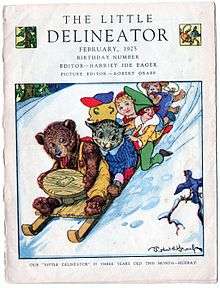Butterick Publishing Company
The Butterick Publishing Company was founded by Ebenezer Butterick to distribute the first graded sewing patterns. By 1867, it had released its first magazine, Ladies Quarterly of Broadway Fashions, followed by The Metropolitan in 1868. These magazines contained patterns and fashion news.[1]
Early publications
In 1873, Butterick created The Delineator magazine. By 1876, E. Butterick & Co. had become a worldwide enterprise selling patterns as far away as Paris, London, Vienna and Berlin, with 100 branch offices and 1,000 agencies throughout the United States and Canada.
In the 20th Century
In 1903 the company built the Butterick Building at Spring and MacDougal Streets in Manhattan. In 1926, S.R. Latshaw was president of the Butterick Publishing Co.[2]
One of Butterick's subsidiary companies was the Ridgway Company, which published the pulp magazines Everybody's Magazine and Adventure.[3]
After 1950
In 1961, Butterick licensed the name and trademark Vogue Patterns from Condé Nast Publications, Inc. and purchased its pattern division. The company was purchased in 1967 by American Can Company and became a subsidiary renamed the Butterick Fashion Marketing Co. In the 1970s, sewing lost popularity and sales began to suffer. In 1983 Butterick's management group headed by Bill Wilson and John Lehmann purchased the company from American Can Company. William Proctor Wilson was the first chief executive officer of the privatized Butterick. In 1988 management sold approximately 60 percent of the company to Robert Bass's Acadia Investors. In 1988 Wilson was succeeded as chief executive officer by John Lehmann. In 2001, The McCall Pattern Company acquired Butterick and Vogue Patterns,[4] and it still continued printing and marketing sewing patterns in and under all three lines as of the middle of February 2016.
Children's patterns

Butterick also published a series of pamphlets for children titled The Little Delineator. Designed for both boys and girls, the pamphlets featured eight pages of stories, artwork and contests. Each issue focused on a theme (often a holiday or season). They also featured play ideas (items to make), and on teaching morals and values. The series did not have a fashion focus as did The Delineator, but was more general in outlook. Each issue offered some kind of prize or reward and a Deli-Club membership card. The series did not contain advertising. [5] [6] [7]
Modern times
The company's Butterick Patterns, McCall's Patterns, and Vogue Patterns lines, as stated above, continued to be published as of the middle of February 2016. These continued to be sold from fabric and sewing-supplies stores like Jo-Ann Fabrics and Hancock Fabrics; Walmart commenced to offer them as well.
In addition, the company also expanded its on-line presence.
References
- ↑ http://butterick.mccall.com/butterick-history-pages-1007.php
- ↑ "Butterick Magazines to Merge," The New York Times, June 17, 1926
- ↑ Goulart, Ron. Cheap thrills: an informal history of the pulp magazines. Arlington House, 1972, ISBN 978-0-87000-172-7. (PP. 31-32.)
- ↑ Alan Clendenning (June 5, 2001). "Many say merger is not 'sew' good". Associated Press. Retrieved November 30, 2011.
- ↑ Fundinguniverse.com
- ↑ Butterick.mccall.com
- ↑ Eager, H.; Graef, R. (February 1925). The Little Delineator. The Butterick Publishing Company.
External links
- Official website
- Works by Butterick Publishing Company at Project Gutenberg
- Works by or about Butterick Publishing Company at Internet Archive